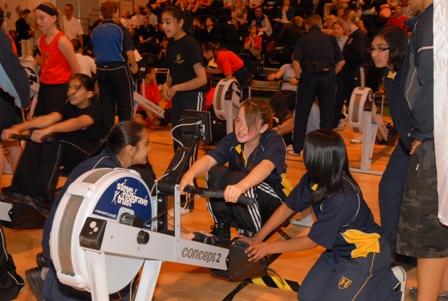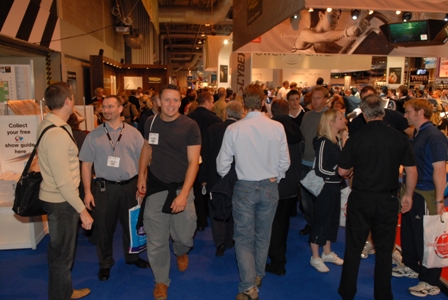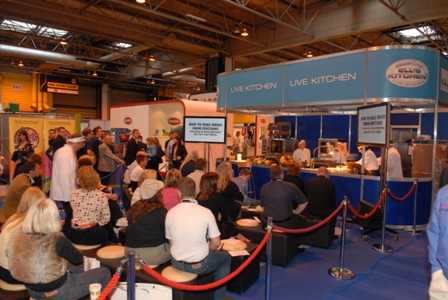
Michael Westcott, LIW supremo

On the ergos at LIW 2007

Visitor numbers are the highest for almost a decade, according LIW organisers

Catering is now an important part of the LIW mix
Under one roof
Is it us or did this year’s LIW seem to have a bit more of a buzz about it? The Leisure Review spoke to Michael Westcott, the man who runs the show, about how leisure’s leading exhibition has changed over the years and what they have planned for the future

Michael Westcott, LIW supremo

On the ergos at LIW 2007

Visitor numbers are the highest for almost a decade, according LIW organisers

Catering is now an important part of the LIW mix
The plan had been to talk to Michael Westcott, director of Ithaca Media’s leisure division and as such the man responsible for developing and delivering the Leisure Industry Week exhibition, for an issue of The Leisure Review in advance of the show. He was keen but, as his diary ticked away towards the first day of LIW, time ran out and we rescheduled for a retrospective. When we do speak the reason for his lack of time quickly becomes clear. Ithaca Media was acquired by CMP Information, a division of United Business Media, just ten days before LIW opened.
Despite this change of ownership, Michael is keen to emphasise that LIW will continue to do what it does under its new owners. “UBM saw the potential and want to invest to take it to the next level,” he said. “LIW will be onwards and upwards.”
Michael took the LIW helm in 2003, a period in which the show, in common with a number of other exhibitions within the leisure sector and beyond, seemed to be going through a difficult period.
“It was a time when I think it would be fair to say that LIW needed a bit of a shot of adrenalin,” he said. “It got a little bit tired about four or five years ago and it needed some new energy. That was what I was tasked with.”
At that time it had become noticeable to regular visitors that the floor space of the show had been shrinking and that operators across the leisure sector were reassessing the impact of the online environment on their marketing spend. In a modern business environment do large-scale exhibitions still have a role as a focal point for business sectors?
“It’s a very good question,” Michael concedes. “I think that exhibitions are a route to market and I think that if anything exhibitions are probably more powerful today than they were ten years ago, before the advent of mainstream internet. The reality is that people like to look each other in the eye when they are doing business and I think that as a route to market exhibitions are probably one of the most accountable in as much as you see what you get. In terms of return on investment, it’s a lead-generating mechanism. There aren’t many places, many media, where buyers walk into a place, stick their hands up and say, ‘I’m here to buy.’
“In the internet age a lot of companies experimented with investing a substantial amount of their marketing dollars into website, which is obviously key as a communication tool with customers but also as a marketing and advertising medium. A lot of people have found that the internet medium itself has become fragmented and extremely cluttered. People experimented for a while but a lot of them have come back to the more traditional media.”
Michael argues that while business-to-business advertising has come under pressure, hitting areas like trade magazines particularly hard, specifically targeted marketing and exhibitions have come into their own over the last few years.
“People like to talk to people,” he said. “We’re tactile human beings and people like to look at products, touch products and speak to the people behind the services. Exhibitions are a great way of doing that.”
In addressing what LIW needed to get it back on its feet, Michael and his team tried to put themselves in the shoes of the leisure operator who might be prepared to give up a day or two of their time. They asked what would make this time out of the office worthwhile and focused on the education content of the show, including the seminars and presentations from industry leaders, the range of products and services on the show floor, and getting a good mix of features on the show floor.
“Five years ago the balance wasn’t quite right,” Michael said. “I don’t think the content offering was inspiring enough, not deep enough, and I don’t think the mix on the show floor was balanced either. I think we worked hard to address all of those issues and the end result is that the show we have just finished is probably the best show we’ve had in a good decade.”
Judging just how good a show is depends on a mix of anecdotal and empirical evidence. LIW invests heavily in measuring satisfaction levels among visitors and also finding out the sort of people attending. This year’s figures and surveys suggest the highest attendance for eight or nine years and a good mix of levels of seniority.
“We’re getting the most senior people but also the most important line managers that run the back office or the front office functions,” Michael said. “So we’ve got the right balance and mix of people. We’re finding that this year there might be four or five people in the car from a trust, a leisure centre or a family attraction, whereas four or five years ago we might have had one guy coming to have a look. I think we’ve made the show, the content and the education side more relevant to people right across a leisure operation.”
Plans for future developments of the Leisure Industry Week experience are currently focused on offering a home to sport in all its formats, the children’s and young people’s activity sector, and continuing developments in bringing the catering and hospitality sector under the LIW roof.
“There is no event in the UK that brings together all the stakeholders in the future of sport in this country, whether it’s voluntary sector, grass-roots level, right up to the elite level,” Michael said. “By bringing in Sports Development Week I think we’ve achieved that and I think we’ll see significant growth there. With the Olympic halo effect, the growth of sports infrastructure, growth in participation in sport and activity in general, I think we’re in the right place at the right time with the right offering to really provide a proper business-to-business platform for everyone involved in the future of sport in this country. That’s very exciting.
“Another side of things is looking at how we as a leisure industry can improve our offering to young people and children. That’s an area of the show that you’ll see growing significantly, in terms trying to motivate young people to get away from their computer screens and the TV to get out and about, either playing sport or having fun that involves them being much more active, to lead a more active and healthy lifestyle, whether that’s through the food they eat or the activities they undertake outside the home or the classroom. That’s important.
“The other area we’re building on and exploiting is the whole hospitality and catering side of leisure. The most important area for any leisure operator once you’ve got the membership dues or the entrance money, depending on what type of venue you operate, you’ve got to keep families and customers there longer and keep them spending money. I think catering and hospitality is a very important driver of secondary spend in leisure venue and that’s an area we have sought to address significantly at the show. That will keep growing.”
2007 marked the second year of the National Licensed Business Show as part of LIW and, with the changes to licensing laws and the smoking ban, the licensed trade is beginning to reassess its role. Where the mainstay of the traditional licensee on-trade was once a pint and cigarette, food, entertainment and a different approach to customer service are now moving up the agenda at high speed. Feedback from the National Licensed Business Show has been positive and indicative of a new understanding among many operators that they are now firmly in the leisure business.
If balancing these new areas with the existing customer base for LIW presents problems, Michael is also confident that the opportunities are equally obvious.
“If you’re a leisure operator with a sizeable operation you can see why you would need your catering manager, your entertainments manager, you facilities manager and your children’s activity manager in the car with you going to the NEC because there will be something for all of you to see. We are seeing more senior people attending the show because it takes in a much broader range of operational issues now for leisure operators that are serious about improving their offering to customers.”
For details of Leisure Industry Week 2008 visit www.liw.co.uk
© Copyright of all material on this site is retained by The Leisure Review or the individual contributors where stated. Contact The Leisure Review for details.